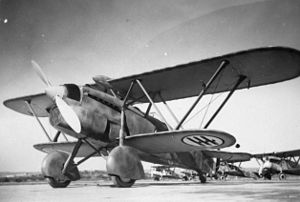Fiat CR.32
| CR.32 | |
|---|---|
 |
|
| CR.32 of Regia Aeronautica in 1939 | |
| Role | Fighter |
| Manufacturer | Fiat |
| Designer | Celestino Rosatelli |
| First flight | 28 April 1933 |
| Introduction | 1933 |
| Retired | 1953 Spanish Air Force |
| Status | Retired |
| Primary users |
Regia Aeronautica Hungarian Air Force Spanish Air Force Chinese Nationalist Air Force |
| Produced | c. March 1934 – February 1936 |
| Number built | 1052 |
| Variants | Fiat CR.42 |
The Fiat CR.32 was an Italian biplane fighter used in the Spanish Civil War and World War II. It was compact, robust and highly manoeuvrable and gave impressive displays all over Europe in the hands of the Italian Pattuglie Acrobatiche. The CR.32 fought in North and East Africa, in Albania, and in the Mediterranean theatre. It saw service in the air forces of China, Austria, Hungary, Paraguay and Venezuela. Used extensively in the Spanish Civil War, it gained a reputation as one of the most outstanding fighter biplanes of all time. It was overtaken subsequently by more advanced monoplane designs and was obsolete by 1939.
The Fiat CR.32 was designed by Celestino Rosatelli. Derived from earlier Fiat CR.30 designs, the CR.32 was a more streamlined and smaller biplane fighter. The prototype MM.201 first flew from the Fiat company airstrip at Turin on 28 April, 1933.
The fuselage had the same structure as the CR.30, utilizing aluminium and steel tubes covered by duraluminium on the nose up to the cockpit, on the back, in the lower section under the tail, and with fabric on the sides and belly. The wings and tail also had a mixed structure, with an aluminium frame covered by fabric. A notable feature was that the lower wing was shorter than the upper wing making it a sesquiplane. Ailerons were only on the upper wings. Armament initially included two 7.7 mm (.030 in) Breda-SAFAT machine guns (later two 12.7 mm (.5 in) Breda-SAFAT), located on top of the engine cowling, with 350 rounds each.
...
Wikipedia
